Today I pedaled my butt off, all the way up to Wisconsin:
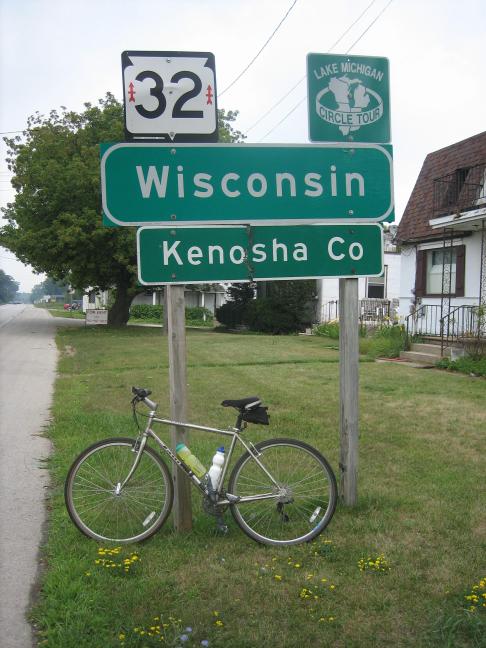
The total ride was 130 km (80.8 mi). I had intended only to go 120 km (74.5 mi) to prepare for the North Shore Century in four weeks. But, I took a wrong turn somewhere in North Chicago, and lost the Robert McClory Bike Path entirely. That added about 6 km (4 mi) to the trip. Another 4 km (2.5 mi) got added on when I popped a spoke in the middle of nowhere:
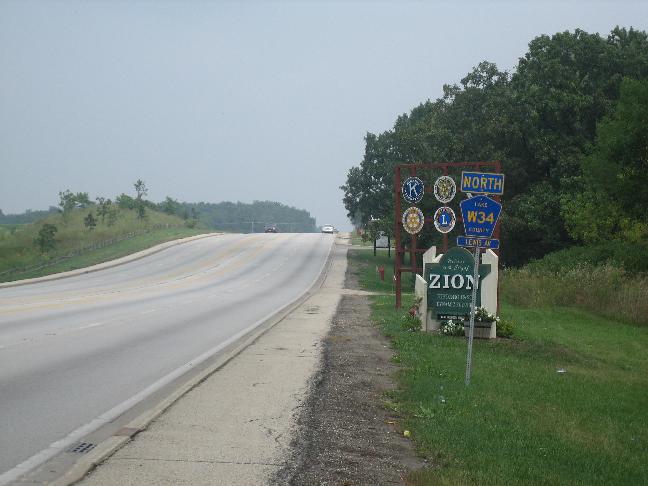
Fortunately, Anne was home and directed me to the Zion Cyclery, and they had me back on the path in under 15 minutes:
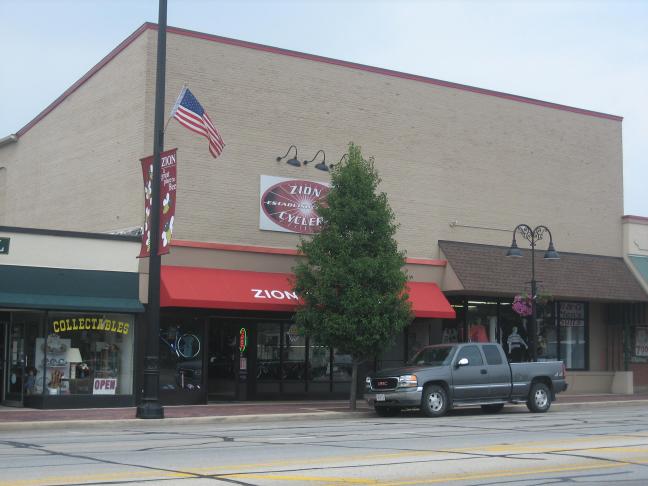
So, a good ride, and now I know I'm ready for the full Century on September 17th.
The Chicago Tribune has a lengthy article about the Chicago Lakefront path, and its many hazards:
Ideally, pedestrians and runners stay to the right of each lane near the perimeter or on the soft, gravel-covered shoulder. Faster traffic—cyclists and in-line skaters—travel on the inside, closer to the yellow line.
During these summer evenings, the minefield emerges, and each group blames the others. Sunbathing near the Ohio Street Beach, in-line skater Roger Mroczek turns and points at a child crossing the trail, oblivious to traffic.
I won't ride down the path during peak hours any more. It's not worth it. Even this morning around 8, I almost ran over a portly gentleman shuffling down the center of the path. Because he had his iPod plugging up his ears, he didn't hear me shouting "on the left" repeatedly.
I ride fast, but I'm always aware of everyone else on the trail. I stay right except to pass, which means faster riders can pass me easier. And I have no problem with runners who do the same—especially when they stay on the gravel shoulders or on the new, elevated running path between North Ave. and Oak St.
But my goodness, anyone, whether on a bike, on foot, or—horrors!—on rollerblades, who takes up the entire lane, deserves road rash.
I'm actually enjoying the International Astronomical Union's discussions about what, actually, is a planet:
The part of "IAU Resolution 5 for GA-XXVI" that describes the planet definition, states: "A planet is a celestial body that (a) has sufficient mass for its self-gravity to overcome rigid body forces so that it assumes a hydrostatic equilibrium (nearly round) shape, and (b) is in orbit around a star, and is neither a star nor a satellite of a planet." Member of the Planet Definition Committee, Richard Binzel says: "Our goal was to find a scientific basis for a new definition of planet and we chose gravity as the determining factor. Nature decides whether or not an object is a planet."
The IAU draft Resolution also defines a new category of planet for official use: "pluton". Plutons are distinguished from classical planets in that they reside in orbits around the Sun that take longer than 200 years to complete (i.e. they orbit beyond Neptune). Plutons typically have orbits that are highly tilted with respect to the classical planets (technically referred to as a large orbital inclination). Plutons also typically have orbits that are far from being perfectly circular (technically referred to as having a large orbital eccentricity). All of these distinguishing characteristics for plutons are scientifically interesting in that they suggest a different origin from the classical planets.
By this definition the solar system has 12 planets, including Ceres, Charon, and UB313 (which one suspects will soon get a "real" name).
On a day like this, when I'm slogging into the wind on Lawrence through heavy traffic and stopping...every...two...blocks for red lights, I just want to finish the ride. But then lately, even my bad rides end up surprising me. Today I did 80 km (50 mi) in unpleasant conditions and still finished in 3:11, more than a minute faster than my best 80 km time.
Next weekend: 120 km (75 mi), which, should I complete it, will be the longest I've ever ridden in one day.
If you don't mind downloading 25 Mb, you can see the short video I took of the cicada who attached herself to my screen while I was working yesterday. To get the full experience turn your speakers up to 11. Those things are ridiculously loud.
They start to come out in Northern Illinois mid-June, and by mid-August they're everywhere. Then, suddenly, around Labor Day, they disappear for another year.
Someone has a cicada blog you might want to check out, if you're into cicadas.
By the way, Chicagoland, next year is our big cicada year, when Brood XIII pokes out of the ground mid-May. In 1990 they not only poked out of the ground, they covered it, generating a noise that can't be described.
I love these guys. Their buzzing just says "summer" to me.
I have decided (by executive fiat) that the "weather" category includes "bicycling." Even though I biked hither and yon as a kid, I kind of lost my passion for it until recently. I'm getting it back, though I still haven't gotten anywhere near the performance I could muster 15 years ago. I just dug up some notes showing that exactly 20 years ago today, I rode 28 km (17.3 mi) in 48 minutes, averaging over 34 km/h (21.1 mph) the whole way. Looking at the other rides recorded in those notes, that was about my average speed then. Today I'm happy to hold 25 km/h (16.1 mph).
Of course, I had a much faster bike then. Angela asked what I'm riding now: it's a Jamis Coda, which is great for running around town but not so great for the kinds of training I've been doing. Actually, riding that thing is like running in jeans: kind of slow, but it builds character. Here it is, shortly after I got it in 2001:
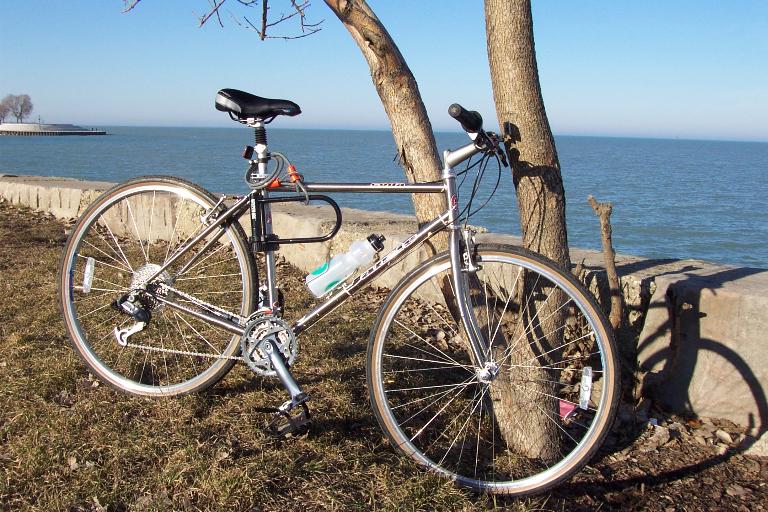
Next season, I will have a road bike for road rides. Oh yes. It will be mine.
Speaking of next season, I have three goals for the next three years. Here they are, time-stamped and in writing, soon to be slurped into the Wayback Machine so there will be no backing out:
- This year, to complete the full 161 km (100 mi) North Shore Century (since the last two years I did the Metric Century of 100 km or 62 mi);
- Next year, to complete a relatively easy[1] multi-day ride, like the 547 km (340 mi) SAGBRAW or the 365 km (225 mi) Katy Trail; and
- In 2008, to complete either RAGBRAI (759 km, 472 mi) or GRABAAWR (788 km, 490 mi).
[1] SAGBRAW is an "easy" ride because it averages only 90 km (56 mi) per day over flat ground, unlike RAGBRAI and GRABAAWR that average 110 km (68 mi) per day and actually have hills.
That's the plan. I'm in the last few weeks of training for the North Shore Century, so expect more photos of far-off destinations between now and September 17th.
As part of my training for the North Shore Century, I set out today to ride 100 km (62.1 mi). I went south, into the wind (so I would have a tail wind for the more-tired half of the ride), and for only the second time in my life rode to another state:
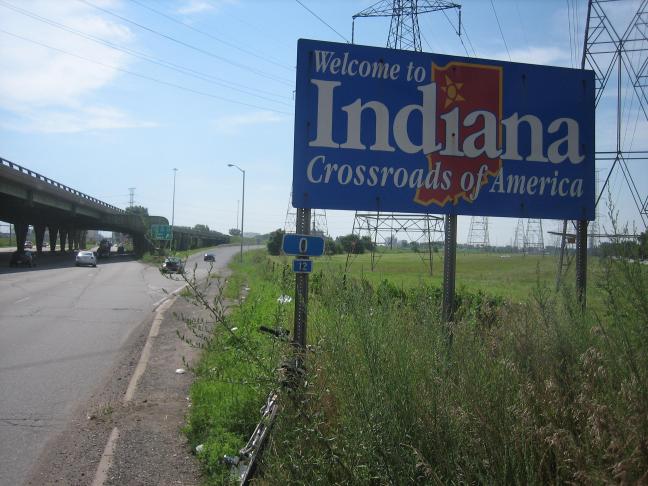
Then I continued all the way to the bottom of Chicago:
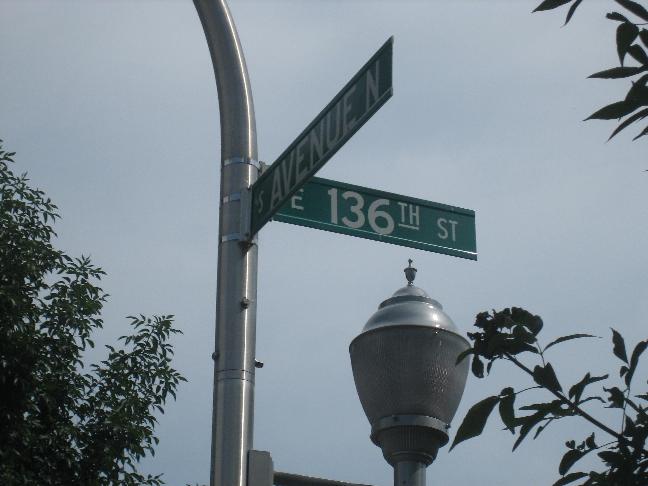
On the way back, only 3.5 km (2.1 mi) from home, a spoke broke. That doesn't sound nearly as bad as it is. When you lose a spoke, the wheel suddenly goes "out of true," meaning it's warped—badly. For a few moments I thought I'd simply run completely out of energy. No, the back wheel was rubbing up against the frame. So Anne had to come get me, and now the bike is at Turin.
Total trip: 96.7 km (60.1 mi) in 3:55:51. My pace was remarkably consistent, just under 25 km/h (15.5 mph), and seven of my 9 splits were withing 30 seconds of each other. This is what long-distance riders look for: consistent power, consistent speed, and consistent pedaling.
The six-day heat wave in Chicago finally broke Wednesday night, giving us delightful summer weather yesterday, but another heat wave is coming. We don't know when, of course; but it's looking more certain that human-caused climate change will give us more frequent and more severe weather events:
While it is impossible to attribute any one weather event to climate change, several recent studies suggest that human-generated emissions of heat-trapping gases have produced both higher overall temperatures and greater weather variability, which raise the odds of longer, more intense heat waves.
Last week, Paul Della-Marta, a researcher at Switzerland's Federal Office of Meteorology and Climatology, presented findings at an international conference on climate science in Gwatt, Switzerland, showing that since 1880 the duration of heat waves in Western Europe has doubled and the number of unusually hot days in the region has nearly tripled.
Fortunately, fewer than 900 days remain in the Bush Administration, but those days include two more summers plus what's left of this one.
From guest blogger Sean:
About Chicago's recent weather—today the temp in Oneida is expected to hit 36°C (97°F). Some areas will likely see 38°C (100°F) or more. I don’t think I've ever seen it this hot in this area before, not in almost 36 years. But after last summer, which was the hottest average summer yet, we really don't want more heat here.
At least we aren't merely baking, though; we're broiling: July finished with an official monthly precipitation total of just over 10 inches. In one month. My tomato garden is now a rice paddock. The water table around my house has risen to just below the two-foot mark. And yet the NWS is telling President Bush the evidence for global warming is "inconclusive?" Excuse me, when upstate NY has already seen over a dozen 32°C (90°F)-plus days this year as of August 1st and this much rain, and the Midwest is another Dust Bowl, and the Ross Ice Shelf in Antarctica continues to erode at an alarming rate, I think there's more than enough conclusive evidence for global warming. How much is human-caused and how much is a larger natural global cycle, now that's the real question, but come on, I think we can draw some very clear conclusions here.
On another and unrelated note, we picked almost 9 gallons of blueberries last week and we’ve just started harvesting blackberries from the pasture—over 2 gallons there yesterday and we can expect many, many more over the next month. The apple trees—which I aggressively pruned—are bearing a nice harvest of fruit. Too bad my tomato plants are flowering at less than half size and speaking Vietnamese. Well, that means next year we create raised beds with better drainage. And dig out the pond as planned.
Sean is a teacher and farmer in Oneida, N.Y.
Update, 18:00 UTC: You can see more of Sean's agony at the experimental Weather Now history page.
As threatened, it hit 37°C (99°F) in Chicago today, making it possibly the hottest July 31st on record. We won't know for sure until tomorrow.
From July 1st until today the average high temperature in Chicago was 29.6°C (85.3°F), modestly above normal, but not quite like those in Jamie's and Angela's home cities, which were 32.2°C (90°F) and 32.4°C (90.4°F), respectively. As Angela pointed out, this is much more normal for Atlanta than it is for here, but that doesn't make it any more pleasant in either city.
Last year, despite an all-time July high of 38.2°C (102°F) in Chicago, the average July highs for Atlanta, Chicago, and Raleigh were 30.4°C (86.7°F), 30.2°C (86.4°F), and 33.8°C (92.8°F), respectively, which were much closer to normal for all three.
But let's review. The average daily high temperature for June in Chicago was 25.9°C (78.6°F), which I think we can all agree was much more pleasant. And, moreover, we chose to live in Chicago, not anywhere South of the 40th parallel, for precisely this reason.
Oh, and another thing: at this writing, it's 34°C (93°F) in Raleigh, 33°C (91°F) in Atlanta, but 37°C (99°F) here. So, yes, my dear Southern friends, it's really quite warm in Chicago right now.